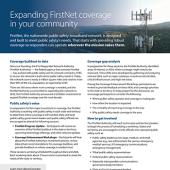One rule of public safety is to be ready for anything. Deputy Chief Gavin Babieracki of Otsego County EMS Rescue shares his experience responding when a tornado struck his community, a rare event in northern Michigan. Though the tornado was unexpected, Babieracki and his team were prepared with FirstNet and other technologies to keep first responders connected throughout the disaster.
Disaster hits
The tornado hit downtown Gaylord, Michigan, a little before 4 p.m. on a Friday afternoon. With max wind speeds of 150 mph and lasting 20 minutes, the storm carved a path 18 miles long and 200 yards wide through Otsego County.
As soon as the tornado touched down, calls poured in for Otsego County EMS Rescue.
“We had reports of individuals trapped inside buildings. We had reports of multiple people with severe trauma walking down the roadway. There were widespread power outages, which also resulted in roadways becoming inaccessible. Houses were completely leveled,” recounted Babieracki.
Babieracki, acting as incident commander, and his team quickly jumped into action. They declared a “county of emergency” and established an emergency operations center (EOC). Soon after, Governor Gretchen Whitmer visited the center, saw the devastation, and declared a state of emergency.
“Our EMS agency transported 53 patients that day, and two people tragically lost their lives,” said Babieracki. “If I showed you a before and after picture, you would never believe that we made it through.”
Mutual aid
The tornado destroyed 38 commercial businesses. Even though Otsego County EMS Rescue is a technical rescue department that performs structural collapse, search and rescue, and hazmat response, they had to call in additional resources due to the extent of the tornado’s damage.
“We immediately requested a five-engine strike team and a five-ambulance strike team from one of our local jurisdictions. We also called mutual aid in from every surrounding county for ambulance assistance,” said Babieracki. “Then we contacted Michigan Task Force One who assembled a team of structural engineers; cadaver dogs; and the best of the best in fire, rescue, and EMS.”
Interoperable communications
As aid from the state and surrounding districts arrived on scene, Babieracki was in the EOC evaluating the situation and assessing communication capabilities.
“When I was initially getting the EOC established, I was carrying seven different 800-megahertz radios, and I was responsible for answering every single one of them,” he said. “Then we discovered that our 800-megahertz system became overwhelmed.”
With the influx of first responders and the governor’s team, he knew interoperable communications would be critical to keeping everyone on the same page.
“We secured some statewide special event channels so that we could all communicate together, but that quickly overwhelmed the towers,” said Babieracki.
They turned to FirstNet. The network was designed and built to keep first responders connected during disasters and in times of high congestion.
FirstNet disaster kit
Otsego County EMS Rescue is a FirstNet subscriber, and all their response units are equipped with a FirstNet device like a smartphone, tablet, or router.
During the tornado response, Babieracki reached out to his local FirstNet consultant to request a deployable. Soon after, a FirstNet Cell on Wheels (COW) arrived to boost connectivity via satellite. The deployable came with a cache of 20 FirstNet phones that Babieracki passed out to department chiefs and branch managers.
FirstNet deployables are available to subscribers 24/7 at no extra cost. These mobile cell sites link to FirstNet via satellite, do not rely on commercial power availability, and provide similar capabilities and connectivity as a cell tower.
Some of the assisting agencies weren’t FirstNet subscribers and commercial towers had sustained damage, leaving those responders without service.
“Our deployable kit came with two hotspots. So, we got a network set up,” said Babieracki. “And within minutes we had everybody connected who wasn't already on FirstNet.”
Advanced communications
Babieracki said the response team used FirstNet for talk, text, and data. They set up talk groups using FirstNet push-to-talk so that responders could contact each other easily.
FirstNet supported advanced communication tasks like connecting to online public safety systems. “Our state is on a web-based EOC platform and incident command system, and our patient tracking is web-based too. It was imperative to have every division logged in,” said Babieracki.
FirstNet also connected drones flying over the disaster area to give responders better situational awareness. “Being part of a tech rescue team, we have three drones, and two have thermal imaging capabilities,” said Babieracki. “The pilot flying the drone sent the photos to me from a FirstNet device. We wouldn't have been able to do that if we weren't on FirstNet.”
Communications are everything
“Anyone with a public safety background knows that when communication fails, it's a train wreck,” said Babieracki.
With FirstNet, Otsego County responders and mutual aid from throughout Michigan had reliable, interoperable communications during the entire tornado response and recovery.
“We never had that loss of communication. My field crews had zero disruption in connectivity,” said Babieracki. “Communication is probably the single most important thing in these types of events, and you don't realize how important until you're faced with this type of situation.”




















